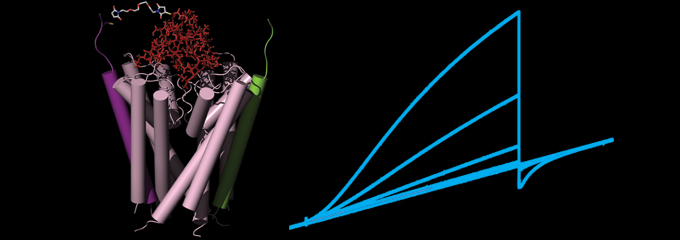Overview

What are Ion Channels?
Ion channels are the proteins that create the electricity in all living cells. Although a solitary ion channel protein possesses the machinery to generate an electrical signal, cells have evolved membrane-embedded partner proteins that associate with and fine-tune the electrical currents of ion channels to achieve the appropriate physiological function for that particular cell. The rhythmicity of the heart beat, maintenance of arterial tone and insulin release by beta cells in the pancreas are all physiological processes that require a healthy association between ion channel and partner protein. Currently, the laboratory focuses on voltage-gated proton and potassium channels; however, lab members have begun to branch out and study other ion channels and their slower, but important cousins - membrane transporters.
Our unique approach
Because the investigation of membrane-embedded multisubunit ion channel complexes poses new experimental challenges, the lab designs and develops novel chemical tools to probe the assembly, structure, trafficking and function of ion channels. We also rely on the powerful techniques of fluorescence microscopy and electrophysiology to address structural, biophysical and physiological questions about ion channel complexes. In addition to using chemistry, the lab focuses on N- and O-glycosylation of ion channel subunits. Unlike previous biophysical investigations of glycosylation, the Kobertz lab delves deep in the ER to monitor the rates of N-glycan attachment to newly synthesized ion channel subunits. This inside-out approach has uncovered why certain genetic mutants give rise to life-threatening cardiac arrhythmias and congenital deafness. Furthermore, the lab has embraced the (often ignored) glycocalyx of the cell and we are exploiting it to visualize ions and metabolites entering and exiting cells.
What are we presently investigating?
The lab focuses on three areas of ion channel research. (1) Kinetics of N-glycosylation: We are determining how these rates affect ion channel assembly and trafficking. In addition, we are investigating the two isoforms responsible for attaching the first N-glycan to nascent ion channel subunits in (and out) of the ER translocational tunnel. (2) Assembly, trafficking and function of cardiac potassium (K+) channel complexes. (3) Fluorescent imaging of extacellular fluxes from cells and living animals.
Read more about N-glycosylation, cardiac K+ channels, or imaging extracellular fluxes!

